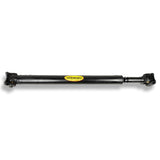Ford Ranger Driveshaft for 2019, 2020, 2021, 2022. Only fits 4x4 Rangers with a shaft length less than 70 inches.
We've heard from many people that their stock drive shaft vibrates and/or shudders, even in brand new un-lifted trucks. The problem gets worse when you lift the truck or change the suspension. The problem is in the two piece design. A two piece shaft is essentially two drive shafts, both have their own requirements for proper angles in order to run smoothly. Adjusting one affects the other and it can sometimes be next to impossible to find the right balance. The single piece shaft eliminates this complexity in favor of a simpler design. We have had very good results with these shafts, however, If you order one and it does not fix your vibration issues you can return it for a full refund within 30 days.
Key product features:
-
Less complex design than the stock shaft. This means less things to cause problems, less things to wear out. In our opinion, the least complicated option is often the best option. This is the key part of the design that reduces the drive shaft shudder and vibrations that are common with the stock shafts.
- Built using 4" diameter, USA made, DOM tubing. The diameter, but also the quality, of tubing being used is meant to maximize the critical speed of the shaft.
- Extra long spline. The longer spline means more contact area between the spline and the slip yoke, about 2X more contact area than a conventional spline. This makes that part of the shaft much more stable and makes it run more smoothly at high speeds. Think of trying to hold onto one end of a stick with two hands instead of one while someone else is trying to wiggle the other end of the stick, that's the concept with the long spline. It costs us a lot more to use these upgraded parts but we think it's worth it.
- 1350 series universal joints. The 1350 series are a bigger, stronger joint than the 1330 series joints in the stock 2-peice shaft we have here as a sample. Bigger joints mean two things. 1. They have a higher breaking strength. 2. The can do the same job longer. Because they exceed the strength requirements of the vehicle they are less likely to fatigue and wear out over time.
- We use non-greaseable joints. Let's be honest, you didn't buy a brand new truck from the dealer with the intentions of doing a bunch of extra maintenance. Because of this, we made the shaft as maintenance free as possible. The joints are pre-greased sealed joints, similar to the stock shaft. There is a grease fitting on the slip yoke but it is very easy to access and can usually be greased by the technician when you get your oil changed. Just make sure to point it out to them.
A couple important things to know about this shaft:
- The reason the carrier bearing is there on the stock shaft is to hold and support the drive shaft. It is not there for ground clearance. It doesn't actually help ground clearance by much if any. Here's why the carrier bearing is there. Imagine your drive shaft is a big pvc pipe, the faster spins the more likely it is to start to flex and bow under its own centrifugal force. The same thing can happen with a steel drive shaft just not as dramatic. The carrier bearing is there to prevent this from happening. The RPM at which the drive shaft might start to flex is basically what we'd call the "critical speed" of the drive shaft. From a technical engineering perspective this is probably not 100% accurate but that's the general concept. Removing the carrier bearing and converting to a single piece shaft changes the critical speed of the shaft. Even though the the single piece shaft works great, it is not without limitations. Namely, critical speed. This can become a problem if the drive shaft is spinning exceptionally fast. How fast the drive shaft is spinning depends on 3 things, vehicle speed, tire diameter, and ring and pinion gear ratio. We have a calculator below you can use to calculate drive shaft RPM at various speed. If you have re-geared your ring and pinion and you live somewhere that has high speed limits your drive shaft RPMs may be too high for the single piece shaft. Increasing tube diameter increases the critical speed. The larger a shaft is in diameter the higher the critical speed, because a bigger diameter tube is more rigid. Because of this, we have decided to build these shafts using a 4" diameter tube. But there as still limitations as to how fast you can safely run the shaft. If you expect regular drive shaft speeds of above 4,000 rpm the stock carrier bearing style shaft is the type of shaft you should be running. These are already pushed limits!
- There's going to be a spacer included with the shaft. The reason it needs a spacer is actually because of the centering pilot/hub on the transfer case output flange. The stock pilot is unusually long, too long for the Spicer flanges we are using. Just by a tiny amount but without the spacer the flange will not seat properly against the transfer case flange. Use the provided pilot spacer and bolts at the transfer case end of the shaft. As far as which end of the shaft you bolt to the transfer case, the slip yoke or the weld yoke, that doesn't matter, you can install it however looks best to you.
- This will not fit your truck if you have the "Tremor" package/version.
We will need a length measurement, measure as shown in the photo on this page from flange to flange. This can be done with the stock shaft still installed.






